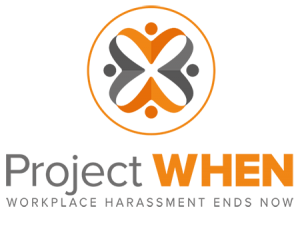Open Office Floor Plan Workplace Research
Trends and Insights on the Future of the Open Office Floor Plan
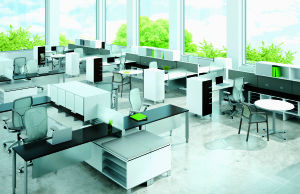 Open office floor plans have been catching on in recent years as organizations realize that implementing such a design can save on real estate overhead and help foster collaboration.
Open office floor plans have been catching on in recent years as organizations realize that implementing such a design can save on real estate overhead and help foster collaboration.
The resistance to these new office layouts has been well-documented, both by pundits in the media and within the client organizations Stegmeier Consulting Group advises each day. We believe that with an effective change management plan, even the most fiercely-resistant employees can thrive in a new work environment, regardless of how open or traditional it is. Nevertheless, the pervasiveness of this topic begs for more data on why (or why not) employees are reluctant to work in an open plan.
To better capture the specific “whys” of resistance, as well gather data on typical current and future planned work environments, Stegmeier Consulting Group conducted a research study – The State of the Open Office. The results will allow those in the workplace sector to inject some real data into the often one-sided discussion of open office floor plans.
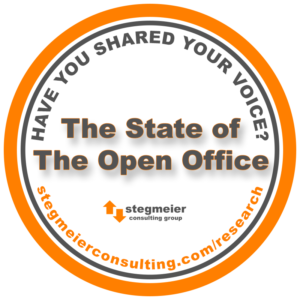 SCG launched this research study at NeoCon 2015 at the historic Merchandise Mart in Chicago. Using data-gathering software, SCG collected information from participants across the globe and representing diverse industries through January 2016. The State of the Open Office Research Study was created with the intent of conducting sentiment analysis for open office concepts, and evaluating trends and patterns regarding concerns and excitement for this type of office layout.
SCG launched this research study at NeoCon 2015 at the historic Merchandise Mart in Chicago. Using data-gathering software, SCG collected information from participants across the globe and representing diverse industries through January 2016. The State of the Open Office Research Study was created with the intent of conducting sentiment analysis for open office concepts, and evaluating trends and patterns regarding concerns and excitement for this type of office layout.
Study participants were invited to respond to questions about their workplace that allowed them to “share their voice” on the subject of open office concepts. The study produced a significant amount of useful information, including many insightful comments that will be highlighted throughout this report. To begin, we would like to share the main themes that were discovered through our research.
- Join the club: Almost all respondents indicated their organization’s most recently completed / next expected office transformation features some level of open plan design.
- Breaking down walls: Many organizations are not hesitant to move their senior leaders out of private offices and into open space.
- On the brink: Slightly less than half (47%) of the study participants indicated their next workplace transformation will occur within the next 18 months, and 58% within the next 3 years.
- World view: The open work environment is being adopted worldwide.
A note from the Stegmeier Team
 The team at Stegmeier Consulting Group is excited to share with you the results of our State of the Open Office Research Study. As specialists in the field of workplace change management, we believe that it is imperative to study current sentiments and trends toward emerging office design concepts. While the open office layout is certainly not new, it is gaining tremendous momentum, and many organizations are adopting the concept.
The team at Stegmeier Consulting Group is excited to share with you the results of our State of the Open Office Research Study. As specialists in the field of workplace change management, we believe that it is imperative to study current sentiments and trends toward emerging office design concepts. While the open office layout is certainly not new, it is gaining tremendous momentum, and many organizations are adopting the concept.
The definition of change is “make or become different.” Our world, and the way in which our clients conduct business, is constantly changing and evolving. Stegmeier Consulting Group has a long history of evaluating and predicting workplace changes, helping client organizations to implement new workplace strategies, and assisting their leaders and employees to embrace new ways of working. Managing workplace change is our passion and purpose.
⇒ Participants
As result of high interest in this topic and the vast network of contacts SCG has cultivated throughout our 14+ years specializing in workplace change management, our study reached participants on six continents, and allowed us to gain insights from professionals in the following fields:
| ➨ Architecture | ➨ Design | ➨ Healthcare | ➨ Pharmaceutical |
| ➨ Automotive | ➨ Engineering | ➨ Higher Education | ➨ Real Estate |
| ➨ Banking | ➨ Finance | ➨ Insurance | ➨ Retail |
| ➨ Construction | ➨ Furniture | ➨ Manufacturing | ➨ Software |
| ➨ Consulting | ➨ Government | ➨ Media | ➨ Technology |
The State of The Open Office Research Study contains insights from a total of 482 individuals, 49 of whom we interviewed in person at NeoCon, and 433 who submitted data electronically at stegmeierconsulting.com. Nearly 200 respondents provided a business email address, allowing our analysts to cross-check each organization’s workforce size for a total representative populace of over 5.5 million employees. While not every employee works in an office environment, this figure is likely quite conservative, taking into account that 59% of all responses were submitted anonymously.
Approximately 20% of participants described their position as Architect, Interior Design, Workplace Consultant, Space Planning and/or Occupancy Planning. Thirty-six percent described their position as Corporate Real Estate, Facilities and IT, and 14% described themselves as being in Sales and Marketing. A breakdown of our participants’ geographic locations follows. This geographic and cultural diversity allowed us to collect many varied perspectives on open office plans.
Aggregate Set of Responses

Responses – North America
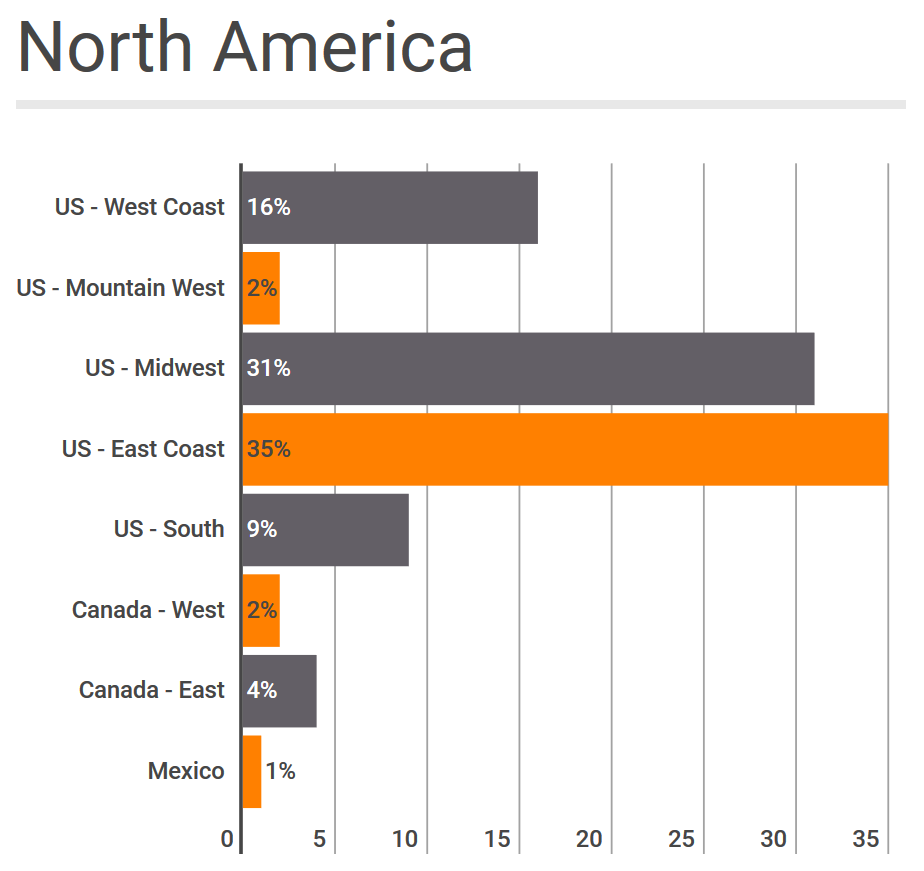
Responses – United States

Responses – Outside of North America
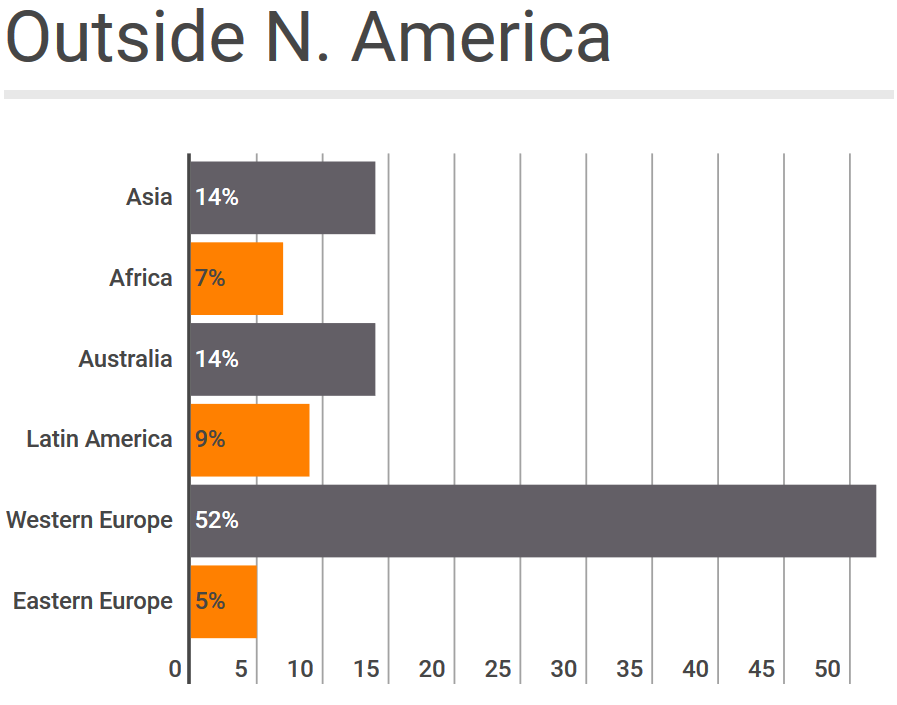
⇒ Analysis
Based on SCG’s broad experience, our analysts had suspicions about which concerns would be ranked highest amongst respondents. Almost any way you slice it, the top three include audible distractions, lack of audible privacy, and uninvited interruptions as the primary concerns of the majority of participants.
The Stegmeier team’s analysis revealed a correlation between respondents who reported recently having moved to a new office environment and their concern over “uninvited interruptions.” For those respondents, “uninvited interruptions” rose to the second-highest concern, replacing “audible privacy.” Our experience providing change management support for clients’ workplace transformation projects reinforces the importance of developing workplace protocols well before the transition to new ways of working, educating the workforce on the etiquette, and setting the expectation that end-users are empowered to reinforce the appropriate behaviors amongst their peers.
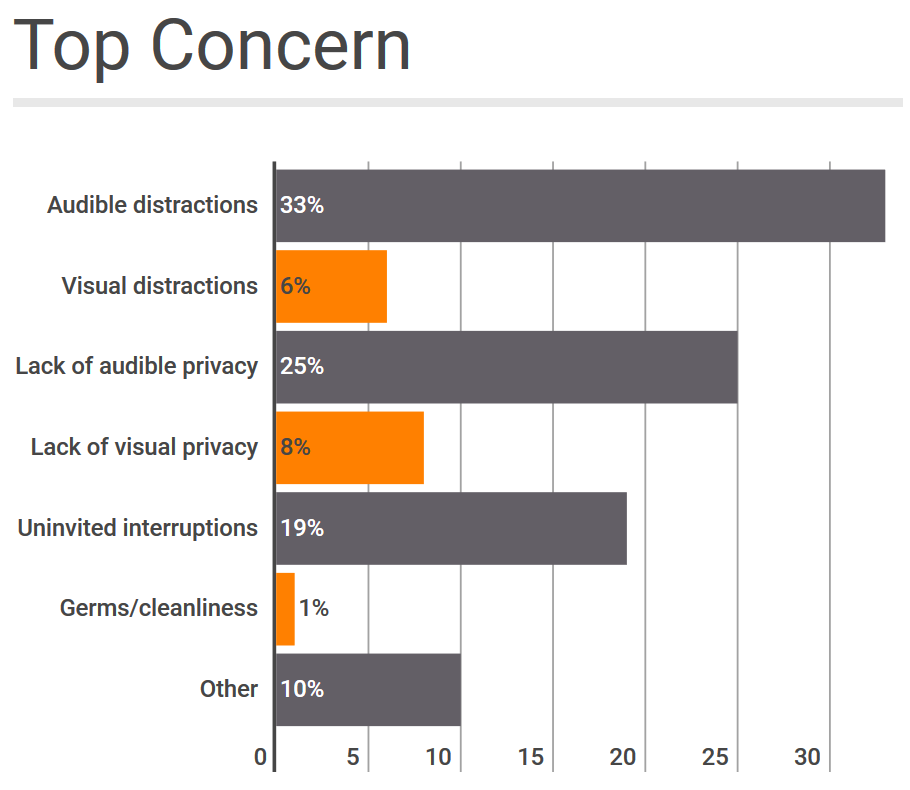
Implementing an open office is often driven by the business objective to increase communication and collaboration. It should come as no surprise that employees new to this type of environment are more visible, and thus deemed more accessible by their coworkers. The most successful design solutions for new work environments provide the right balance between encouraging team collaboration while providing opportunity for individual concentration.
We took a closer look at the 10% of respondents that chose “Other” and found that 21% of these responses had ‘no concerns’ about the open office:
“I’m looking forward to it”
“No problems – I like open offices”
“None come to mind”
Also included in “Other” category – 21% identified some form of audio distraction or noise concern, 21% identified ‘privacy’ or ‘uninvited interruptions,’ and 11% commented that they were concerned about all of the above. Some of the “other” feedback included the following concerns from participants as it pertains to the design concept and functional needs of the workplace:
“Lack of storage space near my workspace”
“Lack of accommodations for certain functions that require privacy”
“Clutter and maintaining a professional appearance in the area”
“If I could say all of the above I would!”
To those organizations considering a transition to an open office environment while targeting a significant reduction in real estate footprint, one best practice that Stegmeier Consulting Group recommends that clients adopt early in the transformation process is an enterprise-wide effort to reduce employees’ reliance on paper, files, and other materials. Unlike activities that must be carefully orchestrated to coordinate with the construction process, a purging initiative or clean- up campaign can be kicked off long before announcing key decisions related to the real estate project.
Let’s continue examining other interesting themes revealed from this study.
Join the Club
A key driver for initiating our research study was to obtain insight as to just how many organizations are moving to some type of progressive work environment, be it assigned open or unassigned (open or otherwise) seating. The results were intriguing.
When we asked participants to identify which direction their organization’s workplace design was heading, we were able to chart a trend that involves a reduction in private offices and assigned cubicles, and an increase in individuals sitting in an open plan in their future office settings.
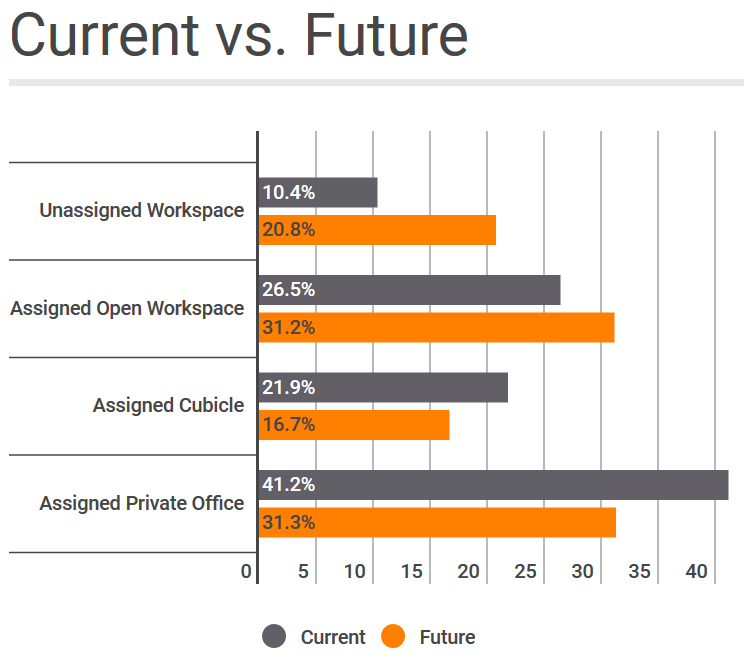
Breaking Down Walls
Whether an organization’s goal is to bring employees together, infuse a workplace with more natural daylight, make more efficient use of a real estate footprint, or all of the above, project teams have recognized the benefits of a more open work environment. As a result, high-walled offices that once lined the perimeters of floor plates are either moving to the center of the workspace, or being removed completely.
Additionally, individual contributors are not the only members of the workforce who are having their workstations converted to a more open office environment.
Executives and leaders have also found that sitting amongst their direct reports in an open environment has increased communication, camaraderie, and a sense of teamwork within their groups. The workstation shift taking place across our participants’ industries is affecting all levels of organizations, and walls are coming down in offices around the world.
Below, you’ll see a breakdown of how the open office shift is affecting all levels of the workplace hierarchy. You will notice that future workplaces will predominantly feature open plans for individual contributors and mid-level managers. Senior leaders and executives are also beginning to shift more towards unassigned or ‘free-address’ workspaces in the open environment.
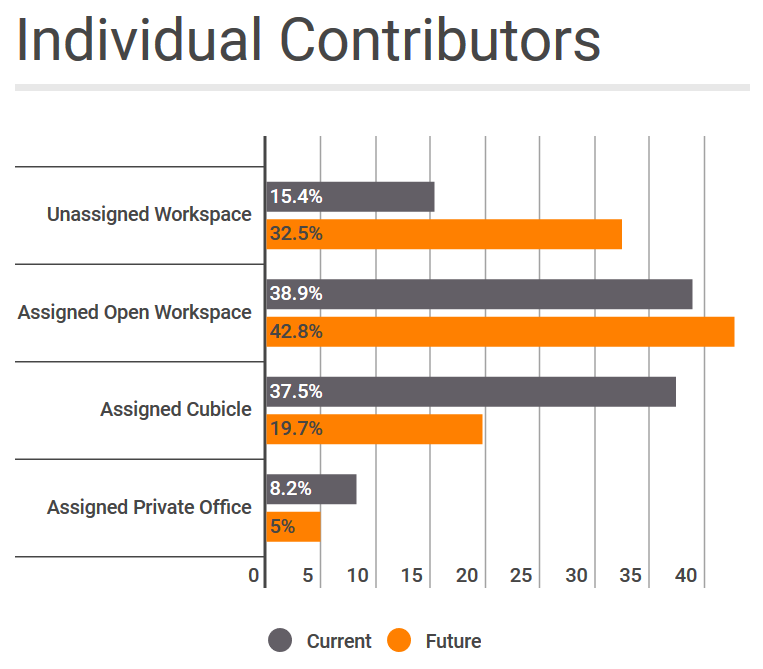
In most organizations, individual contributors (those with no direct reports) are the employees most likely to work in a more progressive work layout. The use of the open office layout is expected to continue for this segment.
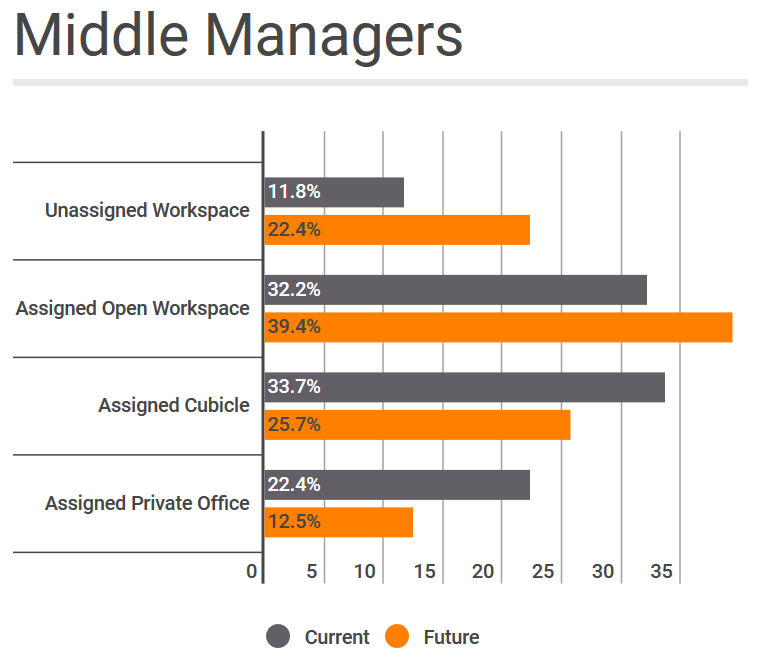
On the whole, respondents indicated that mid-level managers are almost 50% less likely to get an assigned private office moving forward.
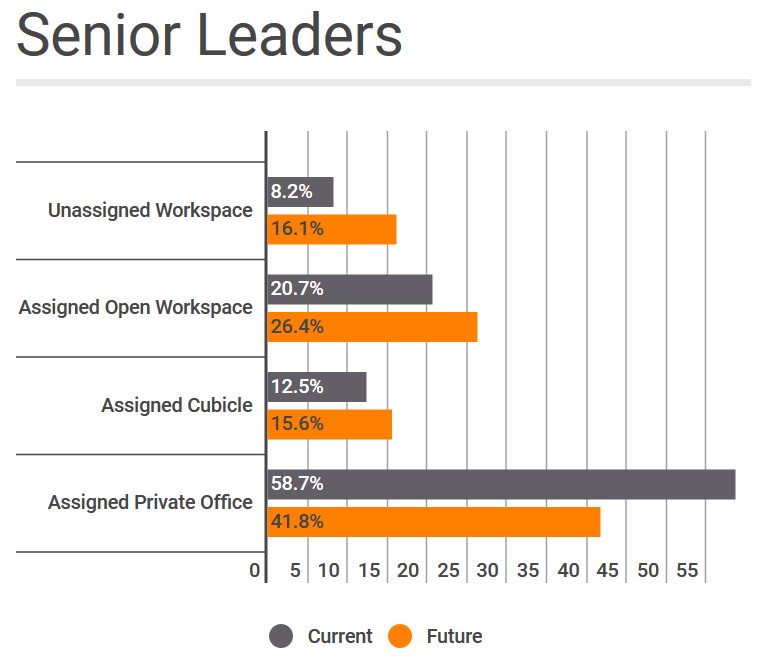
Many senior leaders will likely still have a dedicated cubicle or private office, but over 42% of respondent organizations expect to place these employees in some form of an open or unassigned workspace moving forward.
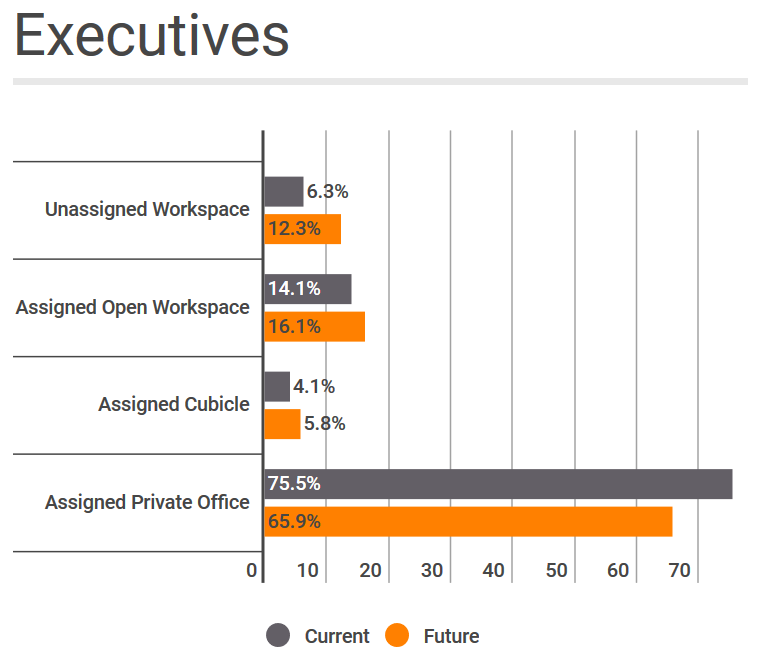
Can you imagine even a few years ago the executive team at your organization coming into work without a dedicated place to sit? While an assigned private office is still the definitive rule for executives, in an increasing number of organizations there is movement towards a more egalitarian workplace, with key members of the C-Suite sitting amongst the general populace.
On the Brink
Office transformations are becoming increasingly popular for myriad reasons, and particularly those transformations leaning toward open office concepts.
The shift toward more open office environments is impacting the types of solutions being provided by architects, interior designers, furniture manufacturers, and corporate real estate brokerages. Aside from the positive collaboration and communication attributes of open office concepts, these designs and workplace strategies also typically afford better access to natural daylight, a greater focus on employee wellness, reduction in corporate real estate costs, and optimized work settings to support the employees’ varied tasks.
Almost half of our study participants indicated a shift to a new work environment occurring within the next 18 months.
The trend appears to indicate that these new workspaces will predominantly feature an open plan for some, or all of their staff. The chart below will help you visualize a timeline of our participants’ workplace changes:
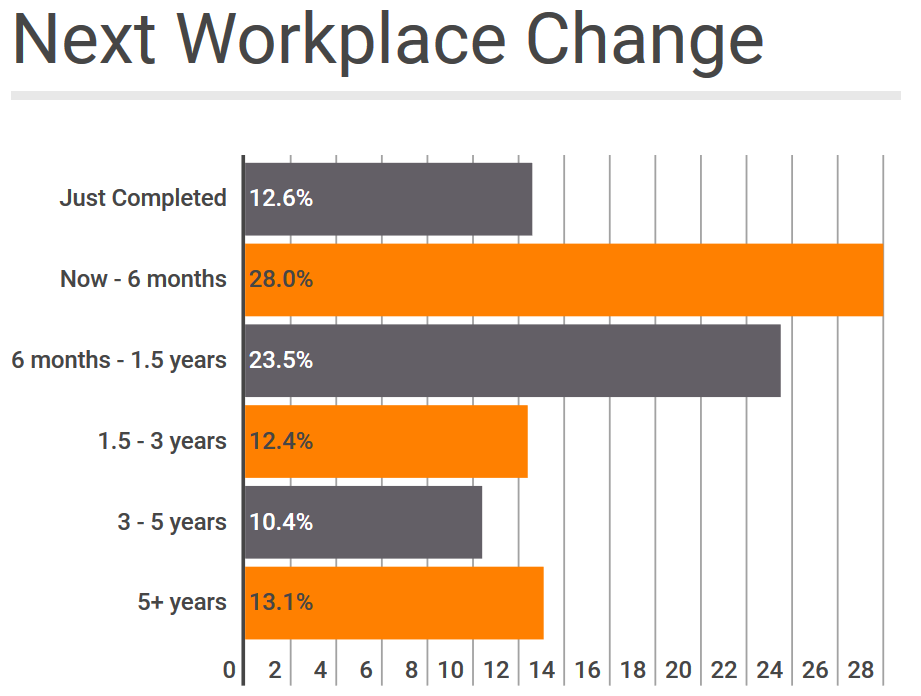
Taking into account expected future office designs and the above time-table, the open office trend doesn’t seem to be disappearing anytime soon, despite any number of opinion pieces that may state otherwise.
World View
It’s interesting to note that in the United States, representing 81% of all responses, almost every region noted the top two open office concerns as audio distractions and audible privacy. The West Coast saw “uninvited interruptions” as a tie for second place of all concerns.
In Europe, the source for our second highest number of research participants, “uninvited interruptions” took a commanding lead over “audible privacy,” the second most prominent concern in open offices. And while the intent of Stegmeier Consulting Group’s study was not to advocate the open office plan as being the appropriate design solution, the data indicated that European organizations have, by far, the strongest adoption rate of open office plans compared to any other responding region. Nearly three quarters of European participants indicated that members at various levels in their organization already work in an open concept, with that number nudging upward slightly in the future.
By comparison, the U.S. has a long way to go to catch up, but certain regions are trending increasingly upward. Open office concepts are most prominent on the East and West Coasts, with each region expecting large upticks in the near future. The Midwest and Southern regions of the United States currently lag behind on implemented open workplaces, but they too are expecting a boost in the coming years. Moreover, study participants from Latin America, South America, Mexico, and Asia all documented an increase in the introduction of the open plan to their workplaces. Participants from Africa anticipate the adoption of open office environments to remain fairly level in the coming years.
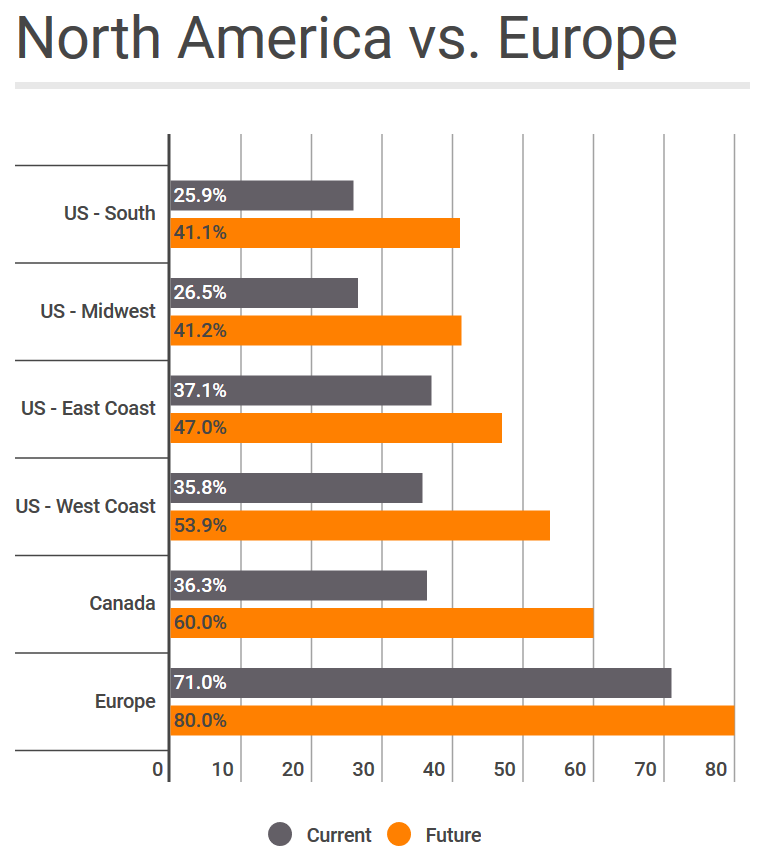
Europe is leading the way with its progressive work environments. Offices in Canada and the U.S. coasts tend to incorporate more modern design elements of unassigned seating and/or open benching, often due to the high cost of real estate and the need to effectively fit more employees into a smaller space. Traditional work environments still reign supreme in the Midwest and South, but are trending more open moving forward.
⇒ Correlation with SCG’s Prior Research Findings
Key discoveries and best practices in developing effective work environments have resulted from Stegmeier Consulting Group’s more than 20 years of research on resistance to workplace change, which involved 208 organizations in 27 diverse industries. The study was initiated in 1996 after witnessing numerous organizations struggle in driving behavioral change through physical workplace transformation. In hearing the frustration of senior business leaders disappointed in the return on investment in the new workplace solution, we established the mission to learn what barriers existed, overtly or covertly, which were not being recognized and addressed by the enterprise.
Data was compiled by Stegmeier Consulting Group on exemplary practices in leading workplace change gathered from a broad range of enterprises throughout North America and Western Europe, with particular attention on winners of Fortune Magazine’s “Best Companies to Work for in America” and the Great Places to Work® Institute’s “Best Small and Best Medium Companies to Work for in America.” In gleaning lessons learned from study participants, goals were established to discover recurring themes in resistance to workplace change and to identify factors having universal impact on behaviors in the work environment, regardless of the organization’s size or industry.
The research study led to our discovery of fifteen such factors. Known as Critical Influences™, these are 15 interdependent tangible and intangible factors that impact 1) behavior in the workplace, 2) success of the workplace strategy, and ultimately, 3) the achievement of organizational results. These factors have a dramatic effect on the dynamic relationship between the organization’s goals and expectations, and employee behaviors.
15 Critical Influences™
| Core Values | Leadership Behavior | |
| Image | Culture | |
| Rewards and Consequences | Technology | |
| Autonomy & Authority | ||
| Performance Management |
As businesses began to successfully apply these discoveries to actionable, comprehensive workplace strategies around the globe, Stegmeier Consulting Group gained additional insights on the power of place in driving organizational change, and the importance of adopting a holistic approach to managing resistance to workplace change:
- The success of workplace transformation is impacted by other influences on the organization’s workforce
- Workplace transformation creates an opportunity to drive other changes necessary for the organization’s success in the future
Stegmeier Consulting Group’s Critical Influence™ approach has proven successful with diverse client organizations around the world.
Our findings on the 15 Critical Influences™ are compiled in the book, Innovations in Office Design: The Critical Influence Approach to Effective Work Environments. The book offers case studies of organizations that have successfully implemented a variety of workplace changes, including transitions to an open office, as well as practical tips for preparing employees for these changes. Each of the fifteen key factors is explored in depth, providing a useful guide to accompany change practitioners along their workplace journey.
⇒ Applying Research Findings on the Critical Influences™ to the Implementation of an Open Office Environment
In benchmarking exemplary workplace transformation projects, Stegmeier Consulting Group has discovered that the most successful design solutions for open office environments are far from being 100 percent open.
We’ve also observed that when done right, open office environments can be some of the quietest we’ve experienced. Offering a variety of work settings that include spaces offering privacy and freedom from distraction will ensure that there are appropriate choices available to support the multitude of tasks being performed by members of the workforce.
Many workplace strategies focused on the open plan integrate activity-based work settings, on-campus mobility, and/or a broad variety of flexible work arrangements. In these organizations, attention has been placed not only on the physical workplace, and on the current and emerging work style of employees, but also on ensuring that the appropriate human resources policies are in place.
Organizational leaders often recognize that the physical workplace has a strong impact on employee behavior, yet several additional factors must be aligned in order to ensure the successful transition to a more open work environment. There are six Critical Influences™ recognized as most significant in implementing a more open office environment:
- Leadership Behavior must reflect the same changes expected of the balance of the workforce. Senior managers claiming exemption from new workplace practices may negatively impact the adoption by their direct reports, and the effect will quickly cascade downward throughout the organization.
- Managers must be held accountable for their employees’ successful adoption of new ways of working through Performance Management. Yet Stegmeier Consulting Group’s research has revealed that managing staff members who may not be seen sitting in one space throughout the day is a tremendous shift in leadership that mid-level managers are typically unprepared to easily accept.
- Members of the workforce must be given the Autonomy & Authority necessary to function in an environment consisting of a variety of work settings from which they can choose. Training must reinforce that rather than owning one dedicated workspace, employees are empowered to select where to work based on the tasks to be performed.
- If the open plan design is implemented in conjunction with a flex work initiative, managers need to understand that working more flexibly should not be considered a Reward granted to employees, but rather one of many methods of ensuring optimal employee performance. Reluctant managers need to be aware that a Consequence of refusing requests for working more flexibly may be their employees transferring to other departments to maintain better work-life fit.
- The Technology used by members of the workforce working in different parts of its headquarters or other locations must be available and reliable so as to avoid employees missing deadlines for the outputs and deliverables for which they are accountable. Individuals working in a more open office environment must become educated on privacy and security risks, and the impact of a breach on customer confidence.
- A new workplace design can set the tone for Culture change and guide the employee behaviors desired by the organization. Attention should be paid to involving employees in the change, rather than having them believe that change is “being done to them,” to prevent a negative impact on employee engagement.
⇒ Recommendations
Participants in The State of the Open Office Survey offered their recommendations for ensuring the success of planning, implementing, and sustaining the intended outcomes of such a workplace strategy. Their comments included:
“Provision enough huddle/phone/conference rooms to go to when needed”
“Being properly prepared for the new work environment”
“Getting balance between need for focus and need for engagement”
“Optional work areas for different activities”
Stegmeier Consulting Group’s advice is centered on the practical application of the Critical Influence™ research findings to areas of resistance and potential solutions. The following table lists the potential resistors in a typical client organization, the specific Critical Influences™ impacting the acceptance and adoption of new ways of working, common gaps/concerns/areas of resistance, and solutions for consideration.
Potential Resistors |
Critical Influences™ |
Potential Gaps/Resistance |
Solutions to Gaps/Resistance |
| All Workforce Members | Physical Workplace | Concern of lost productivity due to visual and acoustical distractions | Ensure the strategy for acoustical treatment takes into account specific work areas.
Establish and reinforce workplace protocols. Help people understand that the ability to focus in an open environment increases with time. |
| Employees | Rewards & Consequences | “If I’m not at my desk all day, how will my manager know that I am working?” | Schedule a lunch & learn or panel discussion with peers and managers on taking ownership of your career. |
| Managers / Senior Leaders | Leadership Behavior | “How can I manage people I can’t see throughout the day? Can I trust my team to work without my oversight?” | Training for managers / senior leaders needs to emphasize focusing on results, rather than on face time. |
| Managers / Senior Leaders | Leadership Behavior | May not feel accountable for the success of the workplace strategy | Leaders must be held accountable for the successful implementation of the new ways of working within their work group. Include as part of quarterly and/or annual performance goals. |
| Managers / Senior Leaders | Image | Expectations to have status reflected in individual workspace | Use current industry information to educate colleagues on workplace trends. Schedule panel discussions with leaders from other offices to discuss new ways of successful working. |
| Employees | Physical Workplace | “The new workplace is really about cutting costs for the company.” | Continue to articulate that the new workplace strategy is not another cost reduction measure, but a necessary measure to conduct business in a global company. |
| Employees | Physical Workplace | Perceived lack of privacy in open work environment | Workplace protocols need to be developed and reinforced. Educate all members of the workforce on the purpose of the various work settings.
Ensure that managers reinforce to all direct reports the autonomy to seek a space offering privacy when needed. |
One recommendation that addresses each of the above areas of resistance is workplace change communication. Transitioning to a new work environment should include messaging in a positive, informative tone. Communications should begin early and be reinforced often to keep your employees up to speed.
Another suggestion that supports each of these areas of resistance is to ensure employees are engaged in the change throughout the transformation process. All too often we see our clients’ workforces frustrated due to being “out of the loop” and disheartened because they feel changes are happening to them, without opportunities to provide input. Handled appropriately, you can give employees a voice, without setting the expectation that they have a vote on their future environment.
Our team works in an open setting, in SCG’s Work Laboratory, experimenting with many of the work behaviors our clients are asking of their employees. The Work Lab page on our website details our challenges and solutions, offering some additional practical advice on how organizations can successfully transition to more progressive work environments.
Thank you for your interest in the findings of Stegmeier Consulting Group’s State of the Open Office Research Study!
⇒ Resources and Suggested Reading
Arnone, Allison; Clary, Abigail; Hetrick, Craig, “Workplace Strategies: 10 Ways to Work Better,” HDR, Inc.
Barajas, Bryan, “How Cultural Transformation Can Improve Performance in Healthcare,” PreCheck, August 19, 2014.
Bartelmay, Ryan, “Get on Board: Communication Goes a Long Way When it Comes to Securing Buy-in,” Perspective: Journal of the International Interior Design Association, Winter 2008 issue.
Buhl, Larry, “Can Telecommuting Hurt Your Career?,” Career Builder, MSN Careers, April 24, 2013, http://www.careerbuilder.com/Article/CB-3310-Workplace-Issues-Can-telecommuting-hurt-your-career/.
CitrixOnline, “10 ways to transform your business by embracing flexible work,” CitrixOnline Solutions Brief, April 2013.
Debelak, Don, “Perfect Phrases for Presenting Business Strategies,” ISBN 978-0-07-163996-5, McGraw Hill Companies, Inc., New York, NY 2010
Ehrlich, Brenna, “11 Tips For Maximizing a Small Office Space,” American Express OPEN Forum, August 25, 2011.
Fister Gale, Sarah, “Some Companies Replace Cubicles with Flex Spaces,” Workforce Magazine, May 30, 2013, www.workforce.com
Gurchiek, Kathy, “Senior Leader Accountability: Critical to Successful Change,” HR News: Society for Human Resource Management, June 2009.
Hannum, Kelly and Kossek, Ellen, “How Flexibility Can Boost Employee Productivity,” Forbes Magazine, June 29, 2011.
Horstkamp, Emmy, “The New Workspace,” HRM Singapore Magazine, May 2009.
Johnson, Emma, “Inspire Employees with Ambience: The Right Work Environment Makes for Motivated and Committed Workers,” Success Magazine, July 22, 2014.
Looby, Kim; Morra, Janet, and Stegmeier, Matthew, “Flexibility at Work,” Facilities Management Journal, September/October 2014, https://www.stegmeierconsulting.com/blog/flexibility-at-work-iron-mountain-a-case-study-on-workplace-change/.
Löfvenhamn, Clara, “Bosses with Private Offices an Endangered Species,” Sweden’s Chef (Boss) Magazine, September 30, 2013, http://chef.se/chef-med-eget-rum-en-utrotningshotad-art/.
Madell, Robin, “Flex Execs: How to Get Your Teammates on Board with Your Telecommuting,” The Glass Hammer, October 1, 2012, http://www.theglasshammer.com/news/2012/10/01/flex-execshow-to-get-your-teammates-on-board-with-your-telecommuting/.
McIntyre, Mike, “Where We Work (Open Office Discussion),” Sound of Ideas, WCPN 90.3, January 22, 2015, https://www.stegmeierconsulting.com/blog/distractions-in-the-open-office-what-you-can-do-diane-stegmeiers-wcpn-interview/.
Morton, Jennie, “The Next Generation of Open Offices,” Buildings Magazine, April 30, 2013.
Murtha, Lisa, “84.51 Degrees: Inside the Most Intriguing New Building in Town,” Cincinnati Magazine, August 11, 2015.
Nilsson, Ola, “Office to Become Social Magnet,” Sydsvenskan Newspaper, Malmö, Sweden, September 30, 2013, http://www.sydsvenskan.se/ekonomi/kontor-ska-bli-sociala-magneter/.
O’Neill, Michael, “Managing Workplace Change: A People-Based Perspective,” Knoll White Paper, Knoll, Inc., New York, 2012, http://www.knoll.com/knollnewsdetail/managing-workplace-change-a-people-based-perspective.
O’Reilly, Charles, “First Selling the Idea to Senior Leaders Helps Organizations Realize Change,” Stanford Graduate School of Business, July 1, 2010, http://www.gsb.stanford.edu/news/research/oreilly_ change_7_10.html.
Oseland, Nigel; Hodsman, Paige, “Planning for Psychoacoustics: A Psychological Approach to Resolving Office Noise Distraction,” Saint-Gobain Ecophon Research Study, April 2015, http://www.ecophon.com/uk/acoustic-solutions/acoustic-knowledge-bank/Make-the-right-room-acoustic-demands-from-the-start/the-sundyberg-study/ [Scroll to end of page].
Palombo Weiss, Ruth, “Hot Topic: Flex-Work,” American Society for Training & Development – LX-Briefing, November, 2012, https://www.td.org/Publications/Newsletters/LX-Briefing/LXB-Archives/2012/11/Hot-Topic-Flexwork.
Perkins, Olivera, “Working from home not for everyone, but it can still be a ‘win-win’ for many workers and employers,” The Plain Dealer, March 28, 2014.
Saunders, Jeffrey, “The Workplace Matters: Insights into Building Successful, Future-Oriented Workplaces,” Copenhagen Institute for Futures Studies, September 23, 2015.
Seddigh, Aram, “The effect of noise absorption variation in open-plan offices: A field study with a cross-over design,” Journal of Environmental Psychology, September 2015, http://www.ecophon.com/uk/acoustic-solutions/acoustic-knowledge-bank/Make-the-right-room-acoustic-demands-from-the-start/the-sundyberg-study/.
Stegmeier, Diane, “Big Shifts: Changing Workforce Perceptions of Office Acoustics,” Ecophon International Acousticians Seminar, Båstad, Sweden, September 2015, https://www.stegmeierconsulting.com/news/ecophon-international-acousticians-seminar-2015/.
Stegmeier, Diane, “Communicating Workplace Change: Starting with the Basics,” Knoll White Paper, Knoll, Inc., New York, 2013, http://www.knoll.com/knollnewsdetail/communicating-workplace-change.
Stegmeier, Diane, “Innovations in Office Design: The Critical Influence Approach to Effective Work Environments,” ISBN 978-0-471-73041-5, John Wiley & Sons, Inc., Hoboken, NJ, 2008. Stegmeier, Diane, “Selling Upward – Securing Leadership Buy-In for Workplace Change,” Knoll White Paper, Knoll, Inc., New York, 2015, http://www.knoll.com/knollnewsdetail/selling-upward.
Stegmeier, Diane, “The Business Case for Web Commuting,” White Paper, Citrix Online, Goleta, CA, 2010.
Stegmeier, Diane, “The Evolution of Change Management: Changing the Way Organizations Manage Workplace Change,” Ecophon Executive Briefing, London, U.K., September 26, 2013, https://www.stegmeierconsulting.com/blog/ecophon-executive-briefing-the-evolution-of-changemanagement/.
Stegmeier, Diane, “The Evolution of Change Management,” WorkTech 2013, New York, NY, May 16, 2013, https://www.stegmeierconsulting.com/blog/worktech-the-evolution-of-change-management/.
Stegmeier, Diane, “The Facility Manager’s Guide to Launching an Alternative Workspace Initiative,” White Paper, PeopleCube, Boston, MA, 2010, Stegmeier, Diane, “The Future Office Workspace,” Ecophon Round Table, Malmö, Sweden, September 25, 2013, https://www.stegmeierconsulting.com/blog/the-future-office-workspace-roundtablediscussion-fall-2013/.
Szaniszlo, Marie, “Work Space … the Final Frontier,” Boston Herald, Boston, MA, April 22, 2012, http://www.bostonherald.com/news/regional/view.bg?articleid=1061126188.
Thornton, Lisa, “When Looks Matter: What a company’s physical space and design reveals about its corporate culture and its appeal to employees and clients,” Change Magazine, Volume 3 Issue 4, August 2013.
Tierney, John, “From Cubicles, Cry for Quiet Pierces Office Buzz,” The New York Times, May 19, 2012.
Download a copy of our research study on open office floor plans
To download a PDF copy of The State of the Open Office Research Study results, simply fill out the form below and request it in the comment box.



